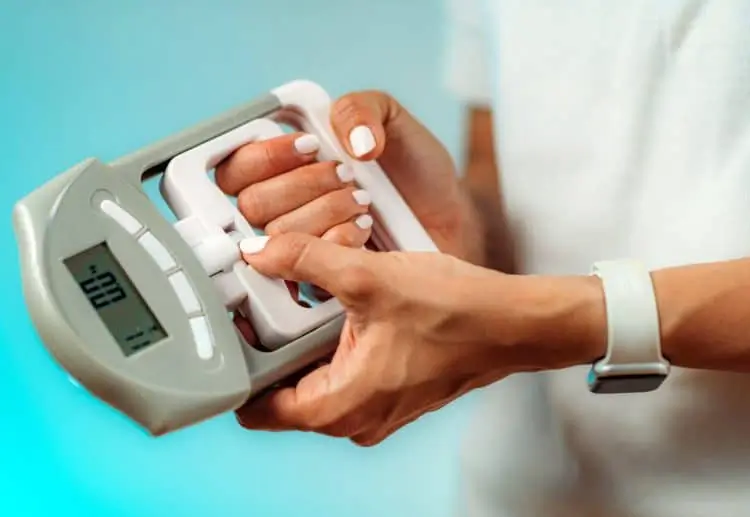Did you know that grip strength can provide valuable insights into your overall health?
It’s true. Grip strength is not just a measure of how strong your hand muscles are; it is also an indicator of your physical fitness and muscular health. And did you know that grip strength norms exist, specifically tailored to different age groups?
When it comes to evaluating grip strength, age-specific norms play a crucial role. These norms are established based on wide-scale population studies and provide a standard against which individuals can compare their grip strength.
By comparing your grip strength with the corresponding norm, you can gain valuable insights into your muscular health and identify potential areas for improvement.
Age-related changes in grip strength are well-documented, with grip strength gradually decreasing as we get older. Factors such as muscle loss, changes in the nervous system, and decreased signal transmission all contribute to this decline.
Understanding how grip strength varies with age can help you better track and evaluate your muscular health as you age.
In this article, we will explore the importance of grip strength dynamometer norms, how they are established through population studies, and how you can utilize them to assess your muscular health. We will also discuss the age-related changes in grip strength and their implications for overall health.
Key Takeaways:
- Grip strength norms exist for different age groups and provide a standard to assess muscular health.
- Age-related changes in grip strength are influenced by factors such as muscle loss and changes in the nervous system.
- Grip strength can provide insights into overall health and is associated with various health outcomes.
- Grip strength dynamometer norms help individuals compare their grip strength values to the average values for their age group.
- Regular assessment of grip strength can help individuals track changes in muscular health over time and take proactive steps towards improvement.
Importance of Grip Strength Dynamometer Norms
Grip strength dynamometer norms play a vital role in assessing hand and forearm strength, and their significance extends beyond mere physical capabilities.
The assessment of grip strength can provide valuable insights into an individual’s overall health and well-being. It serves as a powerful tool for identifying potential health issues and predicting certain health outcomes.
Reduced grip strength is often an indicator of underlying health conditions. For example, a weaker grip strength can be associated with muscular dystrophy, carpal tunnel syndrome, and even systemic problems such as cardiovascular disease.
Research has shown that individuals with reduced grip strength face an increased risk of heart failure, cardiac death, and hospital admission for heart failure.
Additionally, grip strength evaluation has shown promise in predicting survival rates for certain types of cancer, including non-small-cell lung cancer. This demonstrates the potential of grip strength as a valuable prognostic indicator in medical settings.
By establishing grip strength dynamometer norms, healthcare professionals and individuals can compare their measured grip strength to the expected values for their demographic. This enables the assessment of muscular health and can provide early indications of potential health issues.
Regular grip strength assessment based on these norms allows individuals to track changes over time, adjust fitness routines, and take proactive measures to improve their overall health.
The image illustrates the significance of grip strength assessment in evaluating overall health.
Establishing Grip Strength Dynamometer Norms
Grip strength dynamometer norms play a vital role in assessing an individual’s muscular health and evaluating their grip strength. These norms are established through wide-scale population studies, which involve measuring grip strength using a dynamometer in individuals across different age groups and genders.
The collected data is then subjected to careful analysis to determine average values for grip strength norms. This process entails collecting a large amount of data from diverse populations and utilizing advanced statistical methods to identify patterns and trends.
The data analysis for grip strength norms takes into account various factors, including age and gender. These factors are essential as they influence grip strength levels.
By establishing grip strength dynamometer norms based on age and gender, researchers are able to provide a standard against which individuals can compare their own grip strength measurements.
The insights gained from population studies for grip strength norms are invaluable. They allow individuals to understand how their grip strength compares to the average values for their demographic group and evaluate their muscular health accordingly.

Average Grip Strength Norms by Age and Gender
| Age Group | Male (kg) | Female (kg) |
|---|---|---|
| 20-29 | 50.5 | 34.2 |
| 30-39 | 48.9 | 31.7 |
| 40-49 | 46.8 | 29.3 |
| 50-59 | 43.2 | 26.8 |
| 60-69 | 40.1 | 24.5 |
The table above presents average grip strength norms by age and gender. As age increases, average grip strength tends to decrease for both males and females. It is important to note that these values are approximate and can vary depending on the specific population studied.
However, they provide a general reference point for individuals to assess their grip strength in relation to the expected norms for their age group and gender.
Using Grip Strength Dynamometer Norms
Assessing muscular health is a crucial aspect of overall physical fitness. When it comes to evaluating grip strength, using grip strength dynamometer norms can provide valuable insights.
By comparing an individual’s grip strength measurement to established norms for their demographic, we can determine how their grip strength fares in relation to the average. This assessment gives us a better understanding of their muscular health and identifies any areas of weakness that may require attention.
By evaluating grip strength based on norms, individuals can gain insights into their overall muscular strength and take appropriate actions to improve it. Whether their grip strength is below, average, or above the norm, this information serves as a guideline for setting realistic goals and developing tailored exercise routines.
It also helps identify potential health issues early on, as grip strength is often linked to various conditions.
Regular reassessment of grip strength is key to monitoring muscular health over time. By tracking changes and improvements, individuals can make informed adjustments to their workout routines or seek medical advice if necessary.
This proactive approach enables them to maintain and enhance their muscular health effectively.
The Benefits of Using Grip Strength Dynamometer Norms
Utilizing grip strength dynamometer norms offers several advantages in assessing muscular health:
“Assessing grip strength based on norms provides a standardized reference point for evaluating muscular health.”
- Comparative Analysis: By comparing grip strength to established norms, individuals can benchmark their performance against a larger population, gaining insights into their relative strength.
- Identifying Weaknesses: Grip strength dynamometer norms allow individuals to identify specific areas of weakness in their hands and forearms, enabling targeted exercises for improvement.
- Tracking Progress: Regular grip strength assessments based on norms provide a measurable tool for tracking improvements and tracking progress over time.
- Early Detection of Health Issues: Deviations from grip strength norms can indicate potential health issues, prompting individuals to seek appropriate medical attention and intervention.
Using grip strength dynamometer norms not only helps assess muscular health but also serves as a proactive tool for maintaining overall well-being. By monitoring grip strength and leveraging this valuable assessment data, individuals can make informed decisions about their exercise routines and identify potential health concerns early on.
Now that we understand the importance of using grip strength dynamometer norms, let’s explore the relationship between grip strength and age in the next section.
Grip Strength and Age
Grip strength is an important measure of overall physical fitness and health. However, as we age, grip strength tends to decline due to various factors.
The decline in grip strength with age is primarily attributed to the loss of muscle mass. As we get older, our bodies undergo natural physiological changes, including a decrease in muscle tissue. This muscle loss affects the strength and functionality of our muscles, including those in our hands and forearms.
Additionally, age-related changes in the nervous system can also contribute to a decline in grip strength. Nerve fibers responsible for transmitting signals to the muscles may become less efficient, leading to decreased signal transmission and weaker muscle contractions.

| Age Group | Average Grip Strength (in kilograms) |
|---|---|
| 20-29 | 40 |
| 30-39 | 38 |
| 40-49 | 36 |
| 50-59 | 34 |
| 60-69 | 32 |
The table above illustrates the average grip strength values for different age groups. As you can observe, grip strength tends to decline as age increases. By the time a person reaches their 60s, their grip strength is significantly lower compared to younger age groups.
It’s worth noting that age-related changes in grip strength can also be influenced by factors such as lifestyle, physical activity levels, and overall health. Regular exercise, particularly resistance training, can help mitigate the decline in grip strength associated with aging.
Overall, understanding the age-related changes in grip strength is essential for maintaining optimal muscular health as we age. By staying physically active and engaging in exercises that target grip strength, individuals can slow down the decline and maintain functional strength in their hands and forearms.
Conclusion
Grip strength assessment is a critical component of evaluating an individual’s overall health and muscle condition. By measuring grip strength, we gain valuable insights into an individual’s muscular health, helping us identify potential health issues and predict certain outcomes such as heart disease and cancer survival.
Utilizing grip strength dynamometer norms provides us with a valuable tool to compare and evaluate an individual’s grip strength against average values for their specific age and gender. Regular assessment and tracking of grip strength enable individuals to monitor changes over time, enabling proactive steps to improve their muscular health.
Understanding the importance of grip strength assessment and the implications of grip strength norms empowers individuals to prioritize and maintain their overall health and well-being.
By incorporating grip strength assessment into our routine health assessments, we can take proactive steps towards improving our strength and enhancing our overall physical fitness.
FAQ
What is a grip strength test?
A grip strength test is a measurement of the force exerted by an individual’s hand muscles when gripping an object. It is commonly assessed using a dynamometer, which measures the amount of force applied.
Why are grip strength norms important?
Grip strength norms provide a standard by which individuals can compare their measured grip strength and assess their muscular health. They help identify potential health issues and provide insights into an individual’s overall health.
How are grip strength dynamometer norms established?
Grip strength dynamometer norms are generally established through wide-scale population studies. Researchers collect data on grip strength from individuals across different age groups and genders and analyze it to determine average values.
How can grip strength dynamometer norms be used?
Grip strength dynamometer norms can be used to assess an individual’s muscular health by comparing their grip strength with the normative values. Regular assessment can help track changes over time and guide individuals in improving their muscular strength.
Does grip strength decline with age?
Yes, grip strength tends to decline with age. As the body loses muscle mass, grip strength gradually decreases. It peaks in young adulthood and then gradually declines with age.
What is the significance of grip strength assessment?
Grip strength assessment is important for evaluating an individual’s overall health and muscle condition. It provides insights into their muscular health, helps identify potential health issues, and can be used as a predictor for certain health outcomes.




